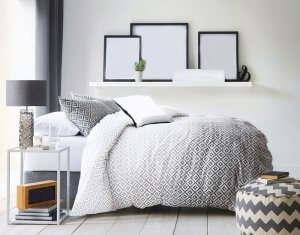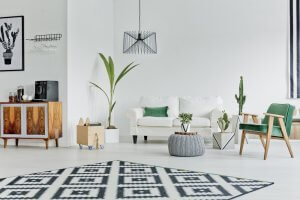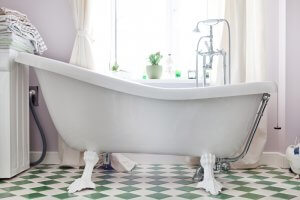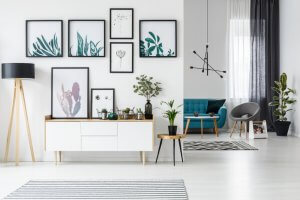How to Use Geometric Shapes in your Decor

Decorating is a complex process: combining colors, choosing complementary elements, establishing a clear differentiation of forms… In today’s article, however, we want to show you how to use geometric shapes in your decor.
What can geometric shapes bring to your home? Firstly, using these common shapes gives us a sense of familiarity. Plus, you can also play around with layout in order to create that perfect sense of harmony.
Like colors, shapes can also be used to fill your home with energy, and convey different feelings and sensations. However, there is a huge variety of geometric shapes, and not all of them work well together. As such, it’s important to know how to choose the right ones.
The search for balance
Firstly, you need to stop and think about what type of decor you want to create. Once you’ve decided that, it’ll be easier to work out which shapes will be best-suited to your home.

As we’ve already mentioned, not every shape is well-suited to interior decor. The shapes you choose will largely depend on the overall effect you want to create.
Choosing complementary colors and shapes is the best way to create a sense of balance. You can’t just choose geometric shapes at random; you have to make sure that they work well with each other, and with the other elements in your home.
Beauty is absolute balance.
Geometric shapes:
So, which geometric shapes should you choose for your decor? Which will work best with your home? The answers to these questions lie in the psychology of geometric shapes, and the emotions they can evoke. Believe it or not, each one has a very different meaning.
- Rectangle: the straight lines reflect feelings of stability and security.
- Square: while they are similar to rectangles, the four equal sides of a square convey a greater sense of uniformity.
- Triangle: while the base of a triangle generates feelings of stability, the three sharp points can create feelings of tension.
- Circle: because it doesn’t have corners, the circle is a softer shape than the others. Full of energy and movement, circles often make people think of the shape of the planet Earth.
- Trapezium: although you might not realize it, trapeziums are one of the most common shapes in interior decor. They create a feeling of stability and strength.
- Rhombus: although they are rarely used in interior decor, incorporating rhombuses is a great way to give your home some character.

These are some of the geometric shapes most commonly found in interior decor. We live side-by-side with these shapes every day, without ever considering just how important they are to our lives.
Geometric shapes
Here are some of the geometric shapes that are best suited to interior decor. It’s important to choose your shapes carefully, making sure they are both practical and beautiful.
- Rectangles: elements such as photo frames, tables, paintings, and mirrors are usually rectangular in shape. You can use patterned geometric wallpaper to incorporate rectangles into your wall decor and create a more original look.
- Square: slightly less common than the rectangle, squares are normally used for furniture, wallpaper, and other decorative elements.
- Triangle: triangles are rarely used, but there are a number of ways you can incorporate them into your decor. You could use patterned wallpaper, or choose small, simple decorative elements for your shelves or tables.
- Circle: often featuring in items such as mirrors, frames, lamps, and wallpaper, circles can make interesting decor for walls, curtains, and tablecloths.
Geometric decor: things to avoid
It’s important to think carefully about how you use geometric shapes in your decor. Every shape is different, so it goes without saying that you shouldn’t try to incorporate all of them into one room. This will only make the room feel cluttered and chaotic.

For example, you could choose the rectangle as your main geometric shape. You can then start to introduce additional shapes, such as circles, whose energy and dynamism serves as a great complement to the stability of the rectangle.
It’s important to know that shapes such as triangles, trapeziums, and rhombuses should be used as complements rather than the central feature. This will help you achieve a greater sense of harmony, and avoid any tension that they might create. When it comes to decorating with geometric shapes, you should always try to create a sense of stability.
In decoration, the main aim is to create harmony.
Decorating is a complex process: combining colors, choosing complementary elements, establishing a clear differentiation of forms… In today’s article, however, we want to show you how to use geometric shapes in your decor.
What can geometric shapes bring to your home? Firstly, using these common shapes gives us a sense of familiarity. Plus, you can also play around with layout in order to create that perfect sense of harmony.
Like colors, shapes can also be used to fill your home with energy, and convey different feelings and sensations. However, there is a huge variety of geometric shapes, and not all of them work well together. As such, it’s important to know how to choose the right ones.
The search for balance
Firstly, you need to stop and think about what type of decor you want to create. Once you’ve decided that, it’ll be easier to work out which shapes will be best-suited to your home.

As we’ve already mentioned, not every shape is well-suited to interior decor. The shapes you choose will largely depend on the overall effect you want to create.
Choosing complementary colors and shapes is the best way to create a sense of balance. You can’t just choose geometric shapes at random; you have to make sure that they work well with each other, and with the other elements in your home.
Beauty is absolute balance.
Geometric shapes:
So, which geometric shapes should you choose for your decor? Which will work best with your home? The answers to these questions lie in the psychology of geometric shapes, and the emotions they can evoke. Believe it or not, each one has a very different meaning.
- Rectangle: the straight lines reflect feelings of stability and security.
- Square: while they are similar to rectangles, the four equal sides of a square convey a greater sense of uniformity.
- Triangle: while the base of a triangle generates feelings of stability, the three sharp points can create feelings of tension.
- Circle: because it doesn’t have corners, the circle is a softer shape than the others. Full of energy and movement, circles often make people think of the shape of the planet Earth.
- Trapezium: although you might not realize it, trapeziums are one of the most common shapes in interior decor. They create a feeling of stability and strength.
- Rhombus: although they are rarely used in interior decor, incorporating rhombuses is a great way to give your home some character.

These are some of the geometric shapes most commonly found in interior decor. We live side-by-side with these shapes every day, without ever considering just how important they are to our lives.
Geometric shapes
Here are some of the geometric shapes that are best suited to interior decor. It’s important to choose your shapes carefully, making sure they are both practical and beautiful.
- Rectangles: elements such as photo frames, tables, paintings, and mirrors are usually rectangular in shape. You can use patterned geometric wallpaper to incorporate rectangles into your wall decor and create a more original look.
- Square: slightly less common than the rectangle, squares are normally used for furniture, wallpaper, and other decorative elements.
- Triangle: triangles are rarely used, but there are a number of ways you can incorporate them into your decor. You could use patterned wallpaper, or choose small, simple decorative elements for your shelves or tables.
- Circle: often featuring in items such as mirrors, frames, lamps, and wallpaper, circles can make interesting decor for walls, curtains, and tablecloths.
Geometric decor: things to avoid
It’s important to think carefully about how you use geometric shapes in your decor. Every shape is different, so it goes without saying that you shouldn’t try to incorporate all of them into one room. This will only make the room feel cluttered and chaotic.

For example, you could choose the rectangle as your main geometric shape. You can then start to introduce additional shapes, such as circles, whose energy and dynamism serves as a great complement to the stability of the rectangle.
It’s important to know that shapes such as triangles, trapeziums, and rhombuses should be used as complements rather than the central feature. This will help you achieve a greater sense of harmony, and avoid any tension that they might create. When it comes to decorating with geometric shapes, you should always try to create a sense of stability.
In decoration, the main aim is to create harmony.







